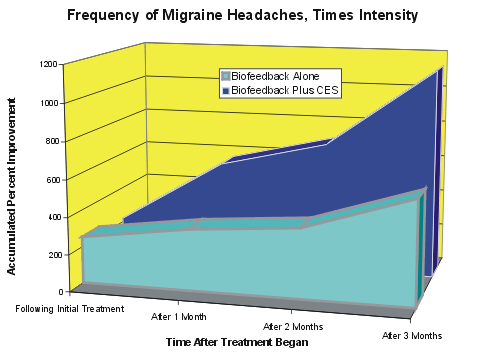Brotman, Philip. Low-intensity transcranial electrostimulation improves the efficacy of thermal biofeedback and quieting reflex training in the treatment of classical migraine headache. American Journal of Electromedicine, 6(5):120-123, 1989. Doctoral dissertation, City University Los Angeles, 117 pages, 1986.
In this double blind study, 36 females, ages 18-40, suffering from classical migraine headaches (ICD-9 346.0), completed informed consent and were randomly assigned to Quieting Reflex Training (QR) and sham CES (N = 12), QR plus actual Alpha-Stim CES (N = 12), or CES only groups (N = 12). All groups were measured for temperature changes using thermal biofeedback (TB) via finger monitors on the dominant hand, and temporalis muscle electromyogram (EMG). All received 8 treatments, plus 1, 2, and 3 month follow-up sessions. Medication levels dropped dramatically from the initial session to the eighth session. T-tests were employed separately for investigation of CES and QR. Results were calculated using the formula of frequency x intensity of headaches. The findings were that groups receiving TB and QR, either with CES (pretreatment mean of 14.42 ± 6.26, post treatment of 4.50 ± 5.30) or with sham CES (pretreatment mean of 15.33 ± 6.62, post treatment of 4.33 ± 4.46), responded significantly better than did the TB CES group alone (pretreatment mean of 14.00 ± 4.56, post treatment of 6.33 ± 4.38), but that the group receiving TB, QR, and CES responded significantly better (mean of .08 ± 0.28) than the TB, QR and placebo CES group (mean of .58 ± 1.19) or the TB and CES group (mean of 8.67 ± 6.60) at the 3 month follow up period. Only the CES group showed significant carryover effects in finger temperature. EMG findings of the CES groups showed a recovery to normal, 15 minutes after treatment. Those groups that did not receive the CES treatment were subsequently treated with CES and they achieved headache reductions comparable to those obtained in the TB, QR, and CES group.
Observations during the study suggested that CES may contribute to both a rapid rise of finger temperature during each session and to a homeostatic rise in finger temperature over time. It was suggested that this was possibly due to a hypothalamic mechanism. No subjects in CES or placebo CES groups reported negative side effects.
|
